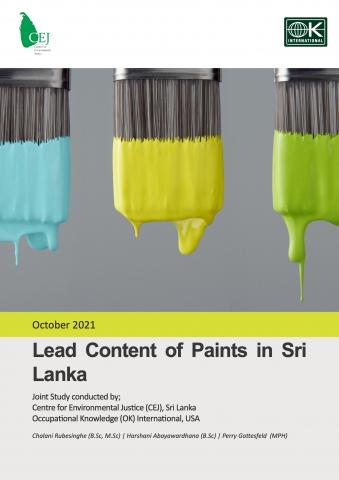Lead Content of Paints in Sri Lanka

The Centre for Environmental Justice (CEJ) first started working on Lead (Pb) paint elimination back in 2009. Ever since, CEJ engaged in advocacy, research, awareness and campaigning in order to make the Sri Lankan paint market lead safe. The purpose of this study was to monitor whether decorative paints with high lead levels are still being sold in Sri Lanka eight years after government restrictions were imposed in 2013.
Key findings of the new study show that most paints have been reformulated to eliminate lead additives but higher lead levels were found in some lacquers and anti-corrosion paints used for metal surfaces. Out of the total of 37 paint samples tested, 14% contained lead at concentrations in excess of 90 ppm (the standard in Bangladesh, Nepal, U.S., Canada and many other countries). Out of the total, 97% of the samples contained lead concentrations below 600 ppm, the legal standard for lead concentration in enamel and floor paints permitted to be sold within Sri Lanka.
The study included 25 paint manufacturers altogether and 20 of them were belonging to Small and Medium paint Manufacturers (SMEs). The results show that 16 out of 20 brands belonging to by SMEs were detected for lead concentration below 90 ppm.
Another independent study conducted by researchers at the University of Colombo published in 2021, using samples collected between November 2014 to April 2015, showed that 22% of the 36 enamel paints tested exceeded 90 ppm lead and 5% of the samples exceeded 600 ppm lead. The study also demonstrated that lead chromate pigments were still used in Sri Lanka after the lead paint restrictions came into place.
These finding suggests that Sri Lanka should update the lead paint standard to a limit of 90 ppm in coordination with other countries as per guidance from the United Nations Global Alliance to Eliminate Lead Paint (GAELP). The current standard restricts the use of lead in specific applications but should be revised to cover all types of paints, coatings, ceramic glazes, and inks. In addition, given the continued use of lead chromate in paints, it should be a priority to ban the import, export, manufacture and use of these carcinogenic pigments as the European Union has already done.
These findings highlight the significant achievement of the efforts of the Centre for Environmental Justice to eliminate lead paint through this ongoing campaign.
| Attachment | Size |
|---|---|
| 4.79 MB |
